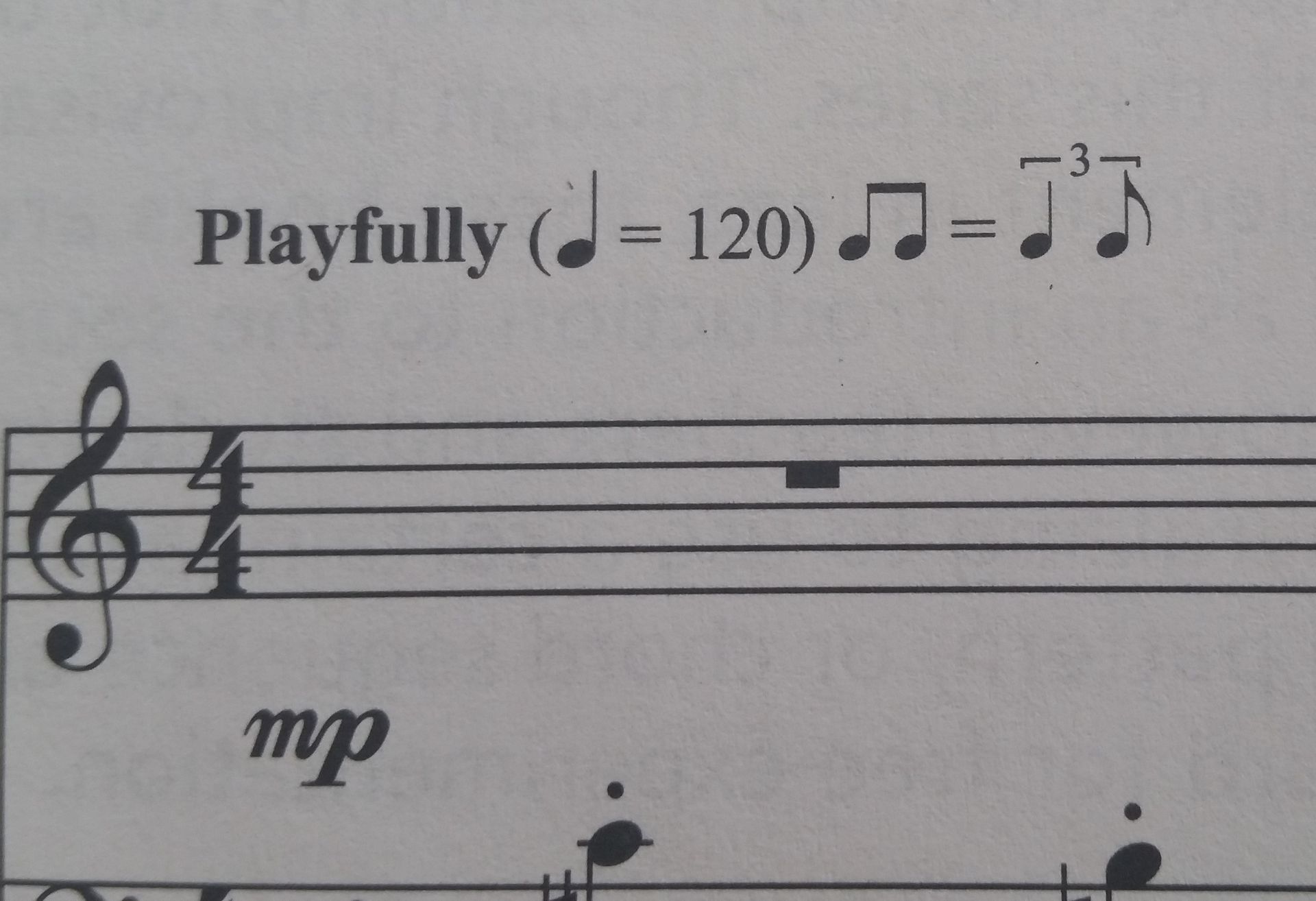Home>Production & Technology>Tempo>What Is The Parenthesis Next To The Tempo In Music


Tempo
What Is The Parenthesis Next To The Tempo In Music
Published: December 10, 2023
Learn what the parenthesis next to the tempo in music means and how it affects the overall rhythm and speed of a musical piece.
(Many of the links in this article redirect to a specific reviewed product. Your purchase of these products through affiliate links helps to generate commission for AudioLover.com, at no extra cost. Learn more)
Table of Contents
Introduction
Tempo is a fundamental aspect of music that dictates the speed at which a piece should be played. It sets the mood, energy, and overall feel of a composition. Musicians and composers use various symbols and notations to indicate the tempo of a piece, allowing performers to accurately interpret and convey the intended musical expression.
One such notation that often accompanies tempo markings is the use of parentheses. These parentheses serve an important role in providing additional information or context about the tempo, helping musicians execute the desired musical interpretation. In this article, we will explore the significance of the parentheses next to tempo markings in music, their different types, and how they are interpreted by musicians.
Understanding the function of these parentheses is crucial for musicians and music enthusiasts alike, as it adds a level of depth and understanding to the performance and appreciation of a piece. Let’s dive deeper into the world of tempo and unravel the mysteries behind the parentheses.
Explanation of Tempo in Music
Tempo is a fundamental element of music that refers to the speed or pace at which a musical composition is performed. It provides a sense of rhythm and timing, shaping the overall character and mood of a piece. Tempo is typically indicated at the beginning of a musical score using specific words or symbols.
The tempo of a piece can vary widely, ranging from slow and tranquil to fast and energetic. Common tempo markings include terms such as Andante (at a walking pace), Allegro (fast and lively), and Adagio (slow and expressive). These terms provide a general indication of the desired tempo, but they can be further clarified or modified through the use of additional symbols or notations.
When it comes to notating tempo, musicians and composers often employ a variety of conventions and symbols. These can include metronome markings, which specify the number of beats per minute (BPM), as well as Italian tempo words, like Moderato (moderate speed) and Presto (very fast). However, it is not uncommon to see parentheses accompanying these tempo markings, providing further information or clarification.
The use of parentheses in tempo notation serves to add context, instructions, or explanations to the tempo indication. It helps musicians understand more precisely how the tempo should be interpreted and executed, enhancing their ability to convey the intended musical expression.
Now that we have explored the basics of tempo in music, let’s delve into the role played by parentheses in tempo notation.
The Role of Parentheses in Tempo Notation
In tempo notation, parentheses play a vital role by providing additional information or modifications to the indicated tempo. They act as clarifiers or qualifiers, helping musicians understand and interpret the tempo more accurately.
One common use of parentheses in tempo notation is to specify a sub-tempo within a larger tempo marking. For example, if the overall tempo marking is Allegro (fast and lively), the use of parentheses may indicate a slightly slower section within that tempo. This enables the performer to adjust the speed accordingly and add a nuanced interpretation to the music.
Parentheses can also indicate changes in the articulation or style of the music. For instance, a tempo marking of Allegro( staccato) suggests playing the notes in a detached and crisp manner. Here, the parentheses provide guidance on the specific technique to be employed while maintaining the overall tempo.
Furthermore, parentheses can be used to indicate tempo fluctuations or variations that occur throughout a piece. These fluctuations, commonly known as ritardandos (gradually slowing down) or accelerandos (gradually speeding up), are indicated within parentheses to communicate the specific sections where the tempo changes occur. This allows performers to navigate the shifts in speed smoothly and enhance the expressive quality of the music.
Another important role of parentheses in tempo notation is indicating metric modulations. A metric modulation refers to a change in tempo by shifting from one rhythmic pattern to another. Parentheses help identify these transitions and provide precise instructions for the performer to execute the change smoothly and accurately.
By utilizing parentheses in tempo notation, composers and arrangers can provide musicians with valuable insights into their musical intentions. These annotations allow performers to approach the music with a deeper understanding, enabling them to convey the desired emotions and expressiveness.
Next, let’s explore the different types of abbreviations commonly found within parentheses in tempo notations.
Types of Abbreviations within Parentheses
When it comes to tempo notation, parentheses often contain abbreviations that provide specific instructions or clarifications related to the tempo. These abbreviations add further context to the indicated tempo, guiding musicians in their interpretation and performance. Here are some commonly used abbreviations within parentheses in tempo notations:
- Accel. – Short for “accelerando,” meaning to gradually increase the tempo. When indicated within parentheses, it signifies a specific section where the tempo should gradually get faster.
- Rit. – Short for “ritardando,” indicating a gradual slowing down of the tempo. This abbreviation, within parentheses, points to a specific section where the tempo should gradually decrease in speed.
- Meno mosso – Meaning “less motion” in Italian. When written within parentheses, it suggests playing the indicated section with a slightly slower tempo compared to the surrounding music.
- Piu mosso – Translating to “more motion” in Italian. When seen within parentheses, it indicates a slightly faster tempo within the specified section of the music.
- Alla breve – Literally meaning “in a brief manner” in Italian. When placed in parentheses, it refers to the tempo of a piece being played in cut time, with the beat represented by a half note rather than a whole note.
- L’istesso tempo – An Italian phrase that translates to “the same tempo.” When found within parentheses, it indicates that the tempo remains constant, despite any key or time signature changes that may occur in the music.
These are just a few examples of the abbreviations frequently encountered within parentheses in tempo notations. Each abbreviation offers specific instructions or modifications to the tempo, allowing musicians to accurately interpret and perform the music as intended by the composer.
Now that we have explored the types of abbreviations commonly found within parentheses, let’s examine how musicians interpret tempo notations with parentheses.
Interpreting Tempo Notations with Parentheses
Interpreting tempo notations with parentheses requires musicians to carefully analyze and understand the specific instructions or modifications provided within the parentheses. These notations offer valuable insights into the desired interpretation of the music and allow performers to deliver a more nuanced and expressive performance.
When encountering parentheses in a tempo notation, musicians should consider the following aspects:
- Context: Pay attention to the overall tempo marking and the surrounding musical phrases. Parentheses often provide context-specific instructions within a larger tempo indication.
- Sub-tempo indications: If the parentheses specify a different tempo within the main tempo marking, it indicates a variation or contrasting section that should be performed at a different speed. Adjust your playing accordingly to reflect this change.
- Articulation and style: Explore any specific instructions within parentheses regarding articulation, dynamics, or style of playing. For example, if the abbreviation “legato” is within parentheses, it suggests playing the notes smoothly and connected.
- Tempo fluctuations: Take note of any ritardandos or accelerandos indicated within parentheses. These fluctuations in tempo provide valuable guidance for shaping the phrasing and expression of the music.
- Metric modulations: If parentheses indicate a metric modulation, understand the rhythmic pattern that follows and prepare for the tempo change accordingly. This ensures a seamless transition between different rhythmic patterns.
It is important to approach tempo notations with parentheses as a roadmap for delivering a more precise and expressive interpretation. Consider the composer’s intentions, the style of the music, and the emotional atmosphere being conveyed.
Remember that while tempo notations with parentheses provide additional instructions, they should not be overly restrictive. Allow yourself room for musical interpretation and personal expression within the given parameters.
By closely examining and interpreting tempo notations with parentheses, musicians can deliver captivating performances that capture the essence and intention of the music.
Now, let’s explore some examples of tempo notations that include parentheses.
Examples of Tempo Notations with Parentheses
To further illustrate the use of parentheses in tempo notations, let’s explore some examples of how they are employed in different musical contexts:
-
Allegro (ma non troppo)
In this example, the parentheses indicate a slightly modified tempo within the overall Allegro marking. The addition of “ma non troppo” suggests that while the piece should be played fast and lively, it should not be overly so. This notation provides a slight restraint on the tempo, allowing for a more controlled and balanced performance.
-
Andante (legato)
Here, the parentheses specify the desired articulation style. The indication of “legato” within parentheses instructs the performer to play the notes smoothly and connected, even at the moderate pace of Andante. This notation adds a specific expressive element to the tempo, emphasizing the importance of maintaining a seamless flow between the notes.
-
Adagio (rit. poco a poco)
In this example, the parentheses include an abbreviation and further instructions. The abbreviation “rit.” indicates a gradual slowing down of the tempo, while “poco a poco” specifies that this change should occur gradually and little by little. This notation prompts the performer to navigate the ritardando with careful and gradual adjustments, adding a sense of heartfelt emotion to the Adagio passage.
-
Presto (alla breve)
Here, the use of parentheses introduces the concept of “alla breve.” This notation indicates a tempo where the beat is represented by a half note rather than a whole note, effectively doubling the perceived speed. Combining the already fast tempo of Presto with the “alla breve” notation creates a lively and energetic pace, challenging performers to showcase their technical prowess.
These examples demonstrate the varied ways in which parentheses are used within tempo notations to provide additional instructions, modifications, or context. It is important for musicians to carefully consider and interpret these notations, allowing them to bring out the intended musical expression and enhance the overall performance.
Now that we have examined examples of tempo notations with parentheses, let’s conclude our exploration of their significance.
Conclusion
The presence of parentheses in tempo notations adds a layer of depth and specificity to the interpretation and performance of music. These parentheses serve various roles, including indicating sub-tempos, specifying articulation or style, marking tempo fluctuations, or denoting metric modulations. By carefully analyzing and interpreting tempo notations with parentheses, musicians can deliver more nuanced and expressive performances that align with the composer’s intentions.
Understanding the different types of abbreviations found within parentheses is essential for deciphering these notations. From abbreviations like “Accel.” and “Rit.” to indications like “Meno mosso” and “L’istesso tempo,” each abbreviation offers valuable instructions or modifications to the tempo, guiding performers in their execution of the music.
Interpreting tempo notations with parentheses requires musicians to consider the context, sub-tempo indications, articulation and style instructions, tempo fluctuations, and metric modulations. By doing so, they effectively navigate through the nuances and variations of the music, delivering a more precise and expressive performance.
Through examples such as Allegro (ma non troppo), Andante (legato), Adagio (rit. poco a poco), and Presto (alla breve), we see how parentheses add further clarification and context to the indicated tempo. These examples demonstrate the diverse ways in which composers utilize parentheses to enhance their musical compositions and communicate their artistic vision.
In conclusion, the use of parentheses in tempo notation provides invaluable guidance to performers, enabling them to accurately interpret and execute the intended musical expression. By embracing and understanding these notations, musicians can bring out the nuances, dynamics, and emotions embedded within the music, delivering captivating performances that resonate with audiences.
So, the next time you come across tempo notations with parentheses, dive in and explore the rich musical world they reveal, allowing yourself to unlock a deeper understanding and appreciation of the music you perform or listen to.











